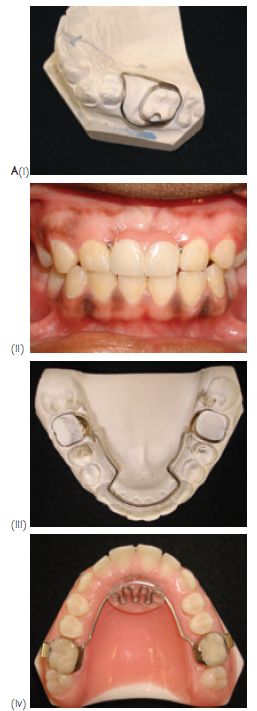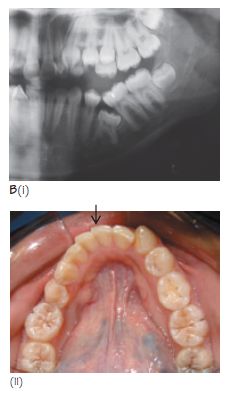28
Interceptive orthodontics
Table 28.1 The sequence of classically described serial extractions.
| Procedure | Notes |
| Extraction of four deciduous canines | Undertaken at the age of approximately 8 years in a child of average dental development, at the time of eruption of the maxillary lateral incisors. This should allow spontaneous alignment of the incisors at the expense of canine space |
| Extraction of the first deciduous molars | Undertaken at the age of approximately 9 years when the roots of the first premolars are half formed. The aim is to encourage the first premolars to erupt before the canines, which is often not the case in the lower arch |
| Extraction of the first premolars | Undertaken near the time of eruption of the canines, after confirming that they are buccaly palpable and mesially angulated, if there is sufficient crowding to warrant premolar extractions and if all other teeth are present and sound. |
Figure 28.1 (A) (i) Band and loop space maintainer to retain the second deciduous molar space, (ii) a partial denture used to replace missing central incisors, (iii) a lingual arch used to maintain lower arch length and (iv) a Nance palatal arch. (B) (i, ii) A case with total submergence of the lower left second deciduous molar. Note the tipping of the adjacent teeth (i) and significant displacement of the centreline to the left (ii).


Interceptive orthodontics involves the early treatment of occlusal disturbances to eliminate or simplify their future management. Such intervention is usually undertaken during the mixed dentition stage of development. Box 28.1 outlines a number of situations encountered during various stages of the developing dentition that may benefit from interceptive treatment. Many of these are discussed elsewhere in detail and the relevant chap/>
Stay updated, free dental videos. Join our Telegram channel

VIDEdental - Online dental courses


